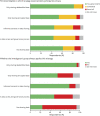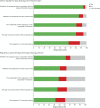Survey of Investigators About Sharing Human Research Data in the Neurosciences
- PMID: 35981894
- PMCID: PMC9576293
- DOI: 10.1212/WNL.0000000000200886
Survey of Investigators About Sharing Human Research Data in the Neurosciences
Erratum in
-
Survey of Investigators About Sharing Human Research Data in the Neurosciences.Neurology. 2023 Jul 18;101(3):147. doi: 10.1212/WNL.0000000000207297. Epub 2023 May 3. Neurology. 2023. PMID: 37137727 Free PMC article. No abstract available.
Abstract
Background and objectives: In the neurosciences, significant opportunities for sharing individual-level data are underexploited. Commentators suggest various barriers to data sharing, which may need to be addressed. Investigators' perspectives on the main barriers are unclear. Furthermore, bioethicists have raised concerns about the potential misuse of neuroscience data, although discussions are hampered by uncertainty about the potential risks. It is unclear how common sensitive data are obtained and whether investigators judge them as sensitive.
Methods: An online survey was disseminated among 1,190 principal investigators (PIs) of active National Institute of Neurological Disorders and Stroke, National Institute of Mental Health, or NIH Brain Research Through Advancing Innovative Neurotechnologies Initiative grants involving human subject research.
Results: A total of 397 investigators responded to the survey (response rate 33%). Most investigators (84%) support efforts to increase sharing of deidentified individual-level data. However, investigators perceive many barriers to data sharing. The largest barriers were costs and time; limited interpretation of the data without understanding the context of data collection; lack of incentives; limited standardization and norms for data acquisition, formatting, and description; and heterogeneity of data types. Several types of data described as sensitive in the literature are common among neuroscience studies, for example, neural correlates of behavior, emotions, or decision making (71%) and/or predictive data (54%). Although most investigators consider it unlikely or extremely unlikely for their research data to be misused to harm individual research participants (82%), the majority were at least slightly concerned about potential harm to individuals if their research data were misused (65%). Investigators with more easily reidentifiable data, data from vulnerable groups, and neural data were more concerned about the likelihood of misuse and/or magnitude of harm of misuse of their research data.
Discussion: We hope these data help prioritize the development of tools and strategies to overcome the main barriers to data sharing. Furthermore, these data provide input on what may be sensitive data for which additional safeguards should be considered.
© 2022 American Academy of Neurology.
Figures




References
-
- Bargmann C, Newsome W, Anderson D, et al. . BRAIN 2025: A Scientific Vision: Brain Research through Advancing Innovative Neurotechnologies (BRAIN) Working Group Report to the Advisory Committee to the Director. NIH, 2014.
-
- NIH. The BRAIN Initiative 2.0: From Cells to Circuits, Toward Cures NIH. NIH, 2019.
-
- Ascoli GA. Mobilizing the base of neuroscience data: the case of neuronal morphologies. Nat Rev Neurosci. 2006;7(4):318-324. - PubMed
Publication types
MeSH terms
LinkOut - more resources
Full Text Sources
